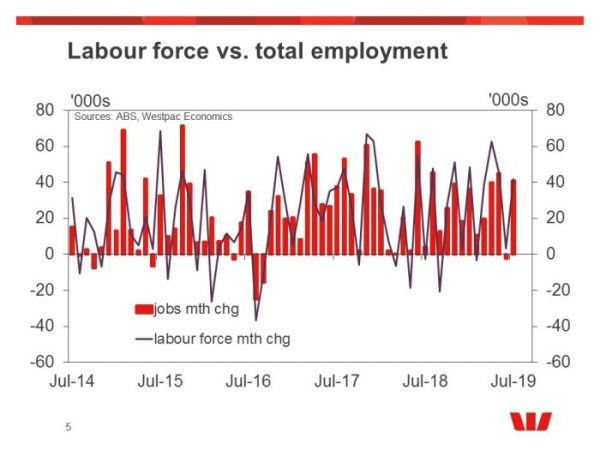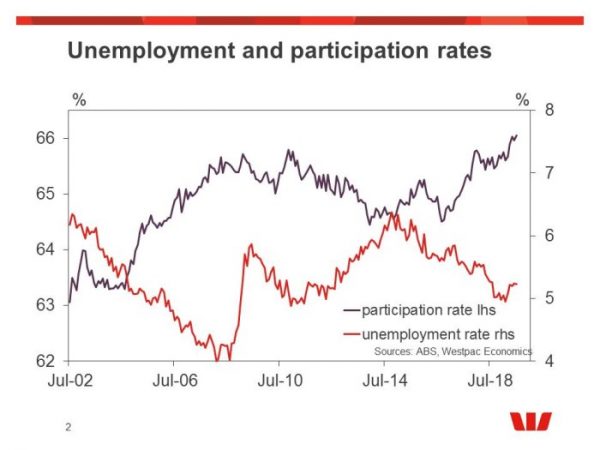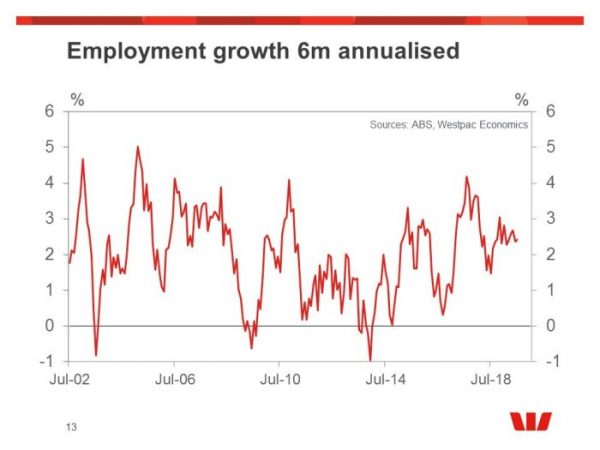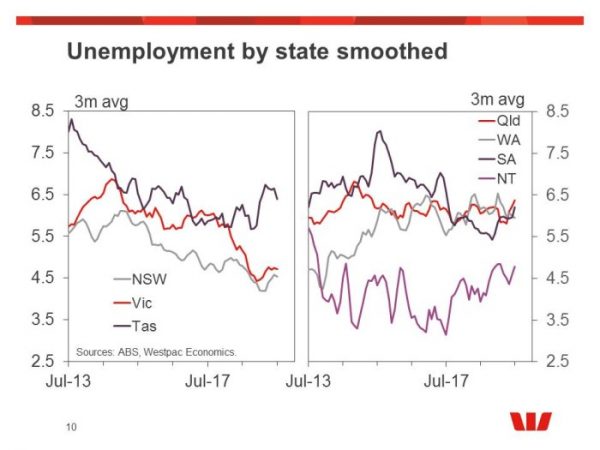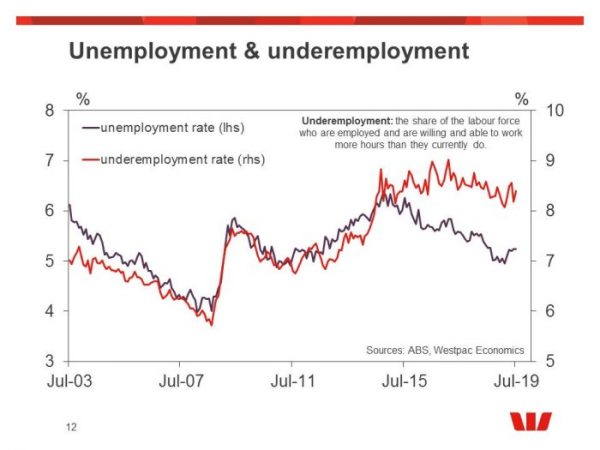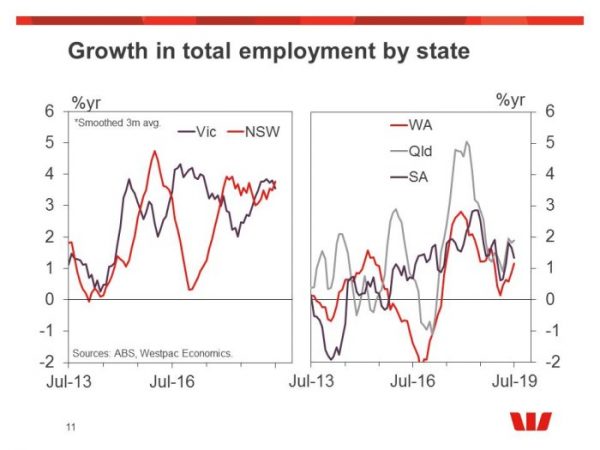Total employment: 41.1k from -2.3k (revised from 0.5k). Unemployment rate: 5.2% from 5.2% (unrevised 5.2%). Participation rate: 66.1% from 66% (unrevised 66%)
A robust update but participation hit a new record high at the same time. So while the employment growth continues to outperform expectations the unemployment rate is very sticky around 5.2%. As such, it is hard to see unemployment getting below 5% any time soon, let alone getting down the RBA’s natural rate of 4.5%.
Westpac is forecasting the unemployment rate to rise from here on the back of a soft patch in employment.
In the past year the largest share of employment gains have been for full-time females, male full-time employment has grown slower than total employment, suggesting employment gains remain focused in the services industries that are rich in female employment.
This update gives us comfort that the RBA will opt to wait-and-see at the September Board meeting and leave the cash rate unchanged.
The July Labour Force Survey reported a 41.1k gain in employment. As we head into the second half of the year, employment remains quite robust with a three month average gain of 28k in July, unchanged from June and slightly down from 35k in May.
The May survey reported a strong +45.2k gain in employment with participation surging to a new record high of 66.1%, boosting the labour force and therefore holding unemployment flat at 5.2% despite the strong gain in employment. Since then, while the month to month employment gains have been volatile, the trend remains robust and unemployment has been flat at 5.2%.
In the year to July, employment has grown 333k or 2.6%. The pace of employment growth has eased back from 2.9%yr in May but it is still stronger than the 2.2%yr at the end of 2018, while the six month annualised pace has was flat at 2.4%yr. Our Jobs Index suggests employment should be growing around 2.4%yr currently before slowing to 2.1%yr through Q4.
We think it is worth noting that June employment was revised to –2.3k from +0.5k with June now recording the first negative print on employment in three years.
In July, unemployment was flat at 5.2% (5.23% at two decimal places – it was 5.24% in June) with participation rising to a new record high of 66.1% (66.06% at two decimal places from 65.96% in June) the labour force grew a very solid 41.9k. We had expected that a soft employment print would have been associated with a moderation in participation so we are not surprised that a robust employment gain is matched by a lift in participation. Today’s update is further confirmation of a robust upward trend in participation, but there was a shift on which state is in the driving seat. NSW hit a record high of participation of 66.2% in May and has since eased back a bit as has Victoria, which leaves Qld supporting the more recent gains in participation.
In June we were surprised by the drop in underemployment (those employed who are willing and able to work more hours) which fell 0.4ppts to 8.2%. Underemployment did not improve as much as unemployment through 2018 and had recently been trending higher compared to the unemployment rate. But in July, underemployment bumped back up to 8.4%, still down on the 8.6% in May but it did help to lock in a stronger trend.
Underemployment lifted in both NSW and Victoria (from 7.5% to 7.9% and 7.9% to 8.5% respectively) while it fell in Queensland and WA (from 8.6% to 8.5% and 9.6% to 9.4% respectively). We note how high underemployment is in Victoria compared to unemployment — unemployment is well below the national average (4.8% vs. 5.2% nationally) whereas the underemployment rate of 8.5% is higher than the national average of 8.2%.
In the last year to July, the gains in employment have mostly been full-time (255.6k/3.0%yr) and with females gaining slightly more than males (153.8k/4.9%yr for females, 101.8k/1.9%yr for males). The mix is interesting as female full-time employment has lifted 153.8k (4.9%yr) in the year while male fulltime rose 101.8k (1.9%yr). In contrast male part-time employment has lifted 59.2k in the year (4.8%) while female part-time grew just 17.8k (0.6%yr). It does appear that employment gains continued to be focused in the services sectors that are rich in female full-time employment positions.
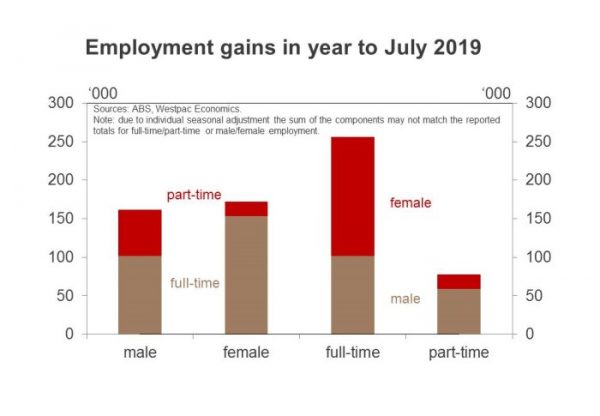 Employment growth has held together and has been quite robust so far in 2019 with the July update suggesting the pace of growth may be picking up — somewhat unexpectedly given the softening leading indicators. Unemployment is flat around 5.2% but underemployment is drifting higher as the employment to population ratio has held around 62.5% to 62.6% since April highlighting that the gains in employment have only been pacing the gains in working age population.
Employment growth has held together and has been quite robust so far in 2019 with the July update suggesting the pace of growth may be picking up — somewhat unexpectedly given the softening leading indicators. Unemployment is flat around 5.2% but underemployment is drifting higher as the employment to population ratio has held around 62.5% to 62.6% since April highlighting that the gains in employment have only been pacing the gains in working age population.
In the year to July, employment has grown 161.4/4.0%yr in NSW compared to 97.8k/3.0%yr gain in Victoria. Employment grew more modestly in Queensland (57.8k/2.3%yr) and just 6.9k/0.8%yr in SA and slight better in WA with 19.5k/1.5%yr in WA.
Since December the unemployment rate has risen 0.1ppt in NSW to 4.4% (the national low), +0.6ppt in Victoria to 4.8% with a smaller 0.3ppt in Queensland at 6.4% but a solid 0.9ppt lift in SA to 6.9%, the highest unemployment rate in Australia. The only state to record a decline in unemployment from December is WA where it fell –0.4ppt to 5.9% which is still above the national average.




